
 Arthur Willard Pryor (September 22, 1869 to June 18, 1942) | |
 Compositions Compositions | |
|
1893
Thoughts of Love1894
Crescent ClubPost-Dispatch March Trocadero March Little Flirt: The Latest Dance 1895
A Kansas Two StepAir Varie Annie Laurie The March King: Two-Step Little Marcia Marie Polka * 1896
Ye Boston Tea-PartyCountry Club Waltzes Sweet Lorena Ray [1] 1897
Little Nell: Song and DanceThe Gridiron: March and Two-Step Sweetheart March 1898
Orange BlossomsLa Spaniola: Waltz Southern Blossoms: A Darktown Two-Step Love Thoughts Waltz A Dark Town: Two-Step 1899
A Coon Band Contest: Cakewalk Two-StepSouthern Hospitality: Rag-time Cake Walk An Arkansaw Huskin' Bee Vanity Fair March The Kentucky Club: Two-Step Bunker Hill: March and Two-Step Liberty Hall: March and Two-Step The Bandmaster: March and Two-Step [2] The Village Belle [2] 1900
The Yankee Prince MarchAn African Beauty: Two-Step 1901
The White Rat's MarchSkipperjack Dance 1902
The Passing of Rag TimeLove's Enchantment Trombone Sneeze [3] Exposition Echoes: Polka 1903
Love's Enchantment: Valse1904
Cherry BlossomsCrusader: Sacred Song [4] The Victor March Blue Bells of Scotland Mr. Black Man: March and Two-Step The Patriot: Polka Caprice On Jersey Shore: March Dance of the Weasels 1905
The Whistler and His Dog: CapriceBlood Lillies: Japanese Two-Step Bherry Blossoms: Japanese Two-Step Razzazza Mazzazza The Irish King: March and Two-Step Down at Asbury Park [5] 1906
Baby Love: A Lullaby [6]The Baby Parade: Two-Step Patrol Frau Louisa: A Comedy Waltz 1907
The Triumph of Old Glory: President's MarchAn Egyptian Love Dance Danny and His Hobby Horse: Caprice After Sunset: Intermezzo After Sunset: Song [7] O God Our Help in Ages Past: Sacred [8] |
1908
Artful Artie: March and Two-StepReal Swing March The Love Kiss: Waltz Captain Cupid: March and Two-Step In Lover's Lane: Tone-Poem 1909
Frozen Bill: RagCanoeing: Idyl Teddy After Africa (a.k.a. In Darkest Africa) 1910
The Arcade Girl: March and Two-StepAfifi March Goody Two Shoes: Caprice Travel, Travel Little Star [9] 1911
Canhanibalmo RagThat Flying Rag Arms of America: March 1914
Toute La Nuit (All Night): RagThe Broadway Tango Aeroplane Dip: Hesitation Waltz (Pryor) Fox Trot 1915
All for You *At the Court of the Jack the Giant Killer * 1916
Heart of America: MarchThe Little Chief: Polka Caprice 1917
We'll Be There Uncle Sammy [10]1919
American Legion March1920
Soldiers of Fortune: March1926
Miami, This is You [11]1928
The Spirit of the Purple March1929
Guardians of the Air: March *1931
We Want Beer: March [12]Oh What Will Television Do to Me? * [12] I'd Love to Love You Again [12] Deep Evening [13] 1937
La Petite SuzanneThe Tip Topper: Polka Will Rogers March (America's Cowboy Philospher) 1939
Starlight: Waltz CapriceThe Supervisor Fantastic Polka 1940
The Whistler's Song1942
We'll Keep Old Glory Flying [14]1943 [Posth]
The Rookie and His Army Mule
1. w/Deamor R. Drake
2. as Milton Willard 3. Disputed. May be Chris Sorenson, Jr. 4. w/James O'Dea 5. w/James Danoday 6. w/Nixon I. Stone 7. w/Alice Mattullath 8. w/Isaac Watts 9. w/Vincent Bryan 10. w/William K. Devereux 11. w/Sue Clement 12. w/Burt Smith 13. w/Eva Williams 14. w/Ada Truax Fletcher * Unpublished |
 Discography Discography | |
|
1893
Arthur Pryor's collective discography with his various bands ranges from the 1903 into the mid-1920s, and is far too extensive to fit in this profile. As the vast majority of his works were recorded on the Victor label, the University of California, Santa Barbara, Library website of American Historical Recordings provides a fairly complete overview of Pryor's recorded works on Victor on a page dedicated to his bands.
| |
Arthur Pryor, born in St. Joseph in northwest Missouri to Samuel Dallas Pryor and Mary Ann "Mollie" Coker, was literally born into music, and on the second floor of the Lyceum Theater to boot. He had an older brother, Walter Dallas (1867) a younger brother, Samuel Otto (1879), and a younger sister, Sallie (1880). While 1870 is traditionally cited as the year of Arthur's birth, his appearance in the Federal census of January, 1870, taken in St. Joseph proves otherwise, making it 1869 for certain. Samuel D. Pryor was the music director for most of the instrumental groups in St. Joseph, including the band and theater orchestra, which is why they lived at the Lyceum. He had been musically trained, and worked as a director of the opera house in Lincoln, Nebraska, before moving southeast to St. Joseph. The family was shown at the Lyceum in St. Joseph in the 1880 census with Samuel as a musician, and Mary's sister, a school teacher, lodging with them. Samuel began teaching his son cornet at the age of five, although he had shown some rhythmic propensity with the drums even earlier. Mollie taught him some piano as well. He would eventually graduate to professional teacher and music theorist Professor William Plato, who would train him for several years. Arthur soon migrated from cornet to alto horn at age six, performing "as a salaried member of his father's band" according to a 1931 article in the Music Trade Review. He moved from that to violin at age nine, and to the valve trombone (ancestor of the slide trombone) by age 11 when he was being billed as the "Boy Wonder from Missouri" at the concerts of Samuel Pryor's band.
It was around this time that Arthur received a used slide trombone that was given to his father in payment of a debt for a printing job. Slide trombones were considered a novelty, relegated to use in some symphonic groups,
and therefore not commonly used in bands. Samuel encouraged Arthur to figure the thing out and practice at it, which Arthur often did at up to ten hours per day. He eventually found out some necessary details from other players, such as using the entire slide, not just one third, and the necessity to keep the slide oiled. He played it at a weekly music competition in town, finally being asked to give other children a chance to win, which he had virtually every time. Arthur soon mastered the instrument, and also took up drums, violin, upright bass, and continued to master the piano. At age thirteen he needed to stand on a soap box in order to reach the top of the neck on the upright bass. By fifteen he was a lead trombonist in his father's band, and gaining a solid reputation. At age 18 Arthur was offered a position with the traveling concert band of Alessandro Liberati, and left home Missouri to go on tour for the next two years.
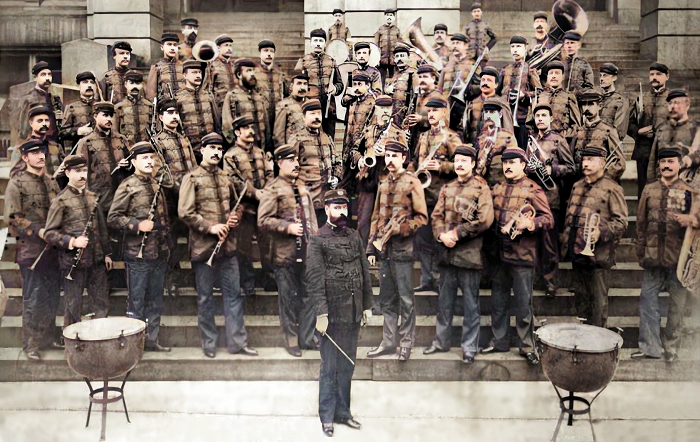 |
One of the problems with being a brilliant soloist on an instrument like the trombone is that little repertoire existed at that time featuring the instrument. So while on tour with Liberati, Arthur set out to change that by writing his own band arrangements with trombone lead. It was during this period around 1890 that famed leader Patrick Gilmore (known as the "Father of the Concert Band") offered the well-reviewed Pryor a position, which was turned down in favor of a steadier position with a small opera company as musical director of the Stanley Opera House in Denver, Colorado. This was possibly due to his father's influence, having done the same type of work for two decades. He also increased his pianistic skills out of necessity during this stint.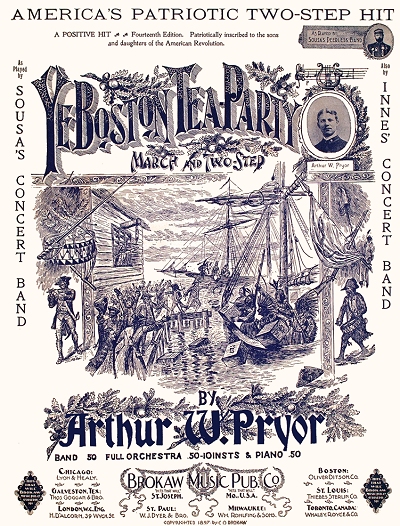 Gilmore had continued to pursue him from time to time, but to no avail. The maestro would pass on suddenly in St. Louis, Missouri, on September 24, 1892, having never secured the young brilliant trombonist.
Gilmore had continued to pursue him from time to time, but to no avail. The maestro would pass on suddenly in St. Louis, Missouri, on September 24, 1892, having never secured the young brilliant trombonist.
 Gilmore had continued to pursue him from time to time, but to no avail. The maestro would pass on suddenly in St. Louis, Missouri, on September 24, 1892, having never secured the young brilliant trombonist.
Gilmore had continued to pursue him from time to time, but to no avail. The maestro would pass on suddenly in St. Louis, Missouri, on September 24, 1892, having never secured the young brilliant trombonist.Soon after this would come a similar offer that Pryor could not refuse. Washington, DC resident John Philip Sousa, who had recently formed his own military band, was well-known enough even though his best pieces were still in front of him. Some of Gilmore's group had migrated to Sousa even before the elder leader's demise, and had told Sousa about the amazing trombonist and multi-instrumentalist. Sousa sent for Arthur, asking him to come audition in New York City. He came with virtually no money, and no return fare, having to sleep on a park bench. The next day, after his extraordinary audition, it is reported that Sousa's lead trombonist, Frank Holton, was ready to resign in deference to Pryor's superior technique. Holton was convinced to stay on, but would soon leave to manufacture trombones that were later endorsed by Arthur Pryor.
It was with Sousa's band that Pryor played at the 1893 Columbian Exposition in Chicago, Illinois. Given that the primary soloist for the band was cornetist Herbert L. Clarke, Sousa was reluctant to feature Pryor so soon in his career with the band, but when Arthur threatened to return to St. Joseph, he relented. Having already been a soloist with the Sousa band on one old standard he had played previously on several occasions, one he had been performing since he was young, Rocked in the Cradle of the Deep, when he first performed his own composition Thoughts of Love for an exposition audience, the reception he received sealed his fate with the leader. His technique, which allowed him to go beyond the usual seven positions available on a trombone slide, proved to be lightning fast and as awe inspiring to watch as it was to listen to. Just the same, he later recounted that he preferred playing ballads in his rich vibrato before he went into fireworks mode. Pryor continued with Sousa for several years, adding both compositions and new techniques to his repertoire.
Arthur is said to have popularized the use of the trombone glissando, a very well controlled refinement of the slide. He also participated in some of the early cylinder recordings of the Sousa band.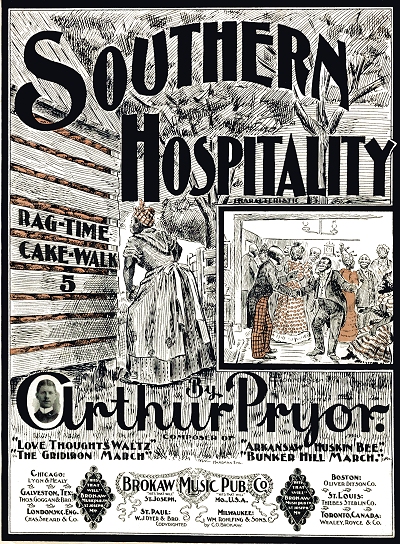 There is one reported incident during a European tour in Leipzig where Pryor played a difficult solo so perfectly that members of the local orchestra disassembled his trombone at intermission to see how the trombone had been enhanced. Finding it to be very ordinary, they were left with nothing but awe for the maestro, who would soon be known as the "Paganini of the Trombone" after the famed 19th century violinist. Some of his bandmates tried his solos out on their respective instruments, but simply could not execute them at any speed approaching that of the electrifying trombonist. His fame further spread in Europe through his early cakewalk and ragtime compositions as performed by the Sousa band, and then back in the United States, in part through early cylinder recordings of the organization.
There is one reported incident during a European tour in Leipzig where Pryor played a difficult solo so perfectly that members of the local orchestra disassembled his trombone at intermission to see how the trombone had been enhanced. Finding it to be very ordinary, they were left with nothing but awe for the maestro, who would soon be known as the "Paganini of the Trombone" after the famed 19th century violinist. Some of his bandmates tried his solos out on their respective instruments, but simply could not execute them at any speed approaching that of the electrifying trombonist. His fame further spread in Europe through his early cakewalk and ragtime compositions as performed by the Sousa band, and then back in the United States, in part through early cylinder recordings of the organization.
 There is one reported incident during a European tour in Leipzig where Pryor played a difficult solo so perfectly that members of the local orchestra disassembled his trombone at intermission to see how the trombone had been enhanced. Finding it to be very ordinary, they were left with nothing but awe for the maestro, who would soon be known as the "Paganini of the Trombone" after the famed 19th century violinist. Some of his bandmates tried his solos out on their respective instruments, but simply could not execute them at any speed approaching that of the electrifying trombonist. His fame further spread in Europe through his early cakewalk and ragtime compositions as performed by the Sousa band, and then back in the United States, in part through early cylinder recordings of the organization.
There is one reported incident during a European tour in Leipzig where Pryor played a difficult solo so perfectly that members of the local orchestra disassembled his trombone at intermission to see how the trombone had been enhanced. Finding it to be very ordinary, they were left with nothing but awe for the maestro, who would soon be known as the "Paganini of the Trombone" after the famed 19th century violinist. Some of his bandmates tried his solos out on their respective instruments, but simply could not execute them at any speed approaching that of the electrifying trombonist. His fame further spread in Europe through his early cakewalk and ragtime compositions as performed by the Sousa band, and then back in the United States, in part through early cylinder recordings of the organization.During one of the Sousa band tours, Arthur met Utah-born Maude R. Russell. They were married on February 19, 1895, in Salt Lake City. The couple soon had a child, Arthur Pryor, Jr., in June of 1896. He would be joined by his brother Roger in August, 1901. After a great deal of international during three European tours, and seasonal domestic travel during the late 1890s as the Sousa organization was quickly building its fame on the compositions of its founder and of Arthur, among others, Pryor and his family were shown back at their home base at the Lyceum in St. Joseph for the 1900 census, staying with his parents and siblings. Samuel D. was still listed as a musician, with Walter as a cornetist, Samuel Jr. as a drummer, and Arthur as a trombonist.
By 1900, Pryor was nearly as famous as Sousa. He had been appointed assistant conductor of the organization in 1895, taking over for Sousa when he was ill or simply needed a day or two off. Given his command of the new ragtime rhythms, he ended up conducting most of those types of numbers in concert and on record, a medium that Sousa saw necessary but did not want to participate in. One of his own compositions, The Coon Band Contest of 1899, had so enthralled Kind Edward VII of England, that he asked that it be played at all of the court concerts during that tour. The same favor was asked by Kaiser Wilhelm of Prussia. Both of these endorsements helped spur sales of Pryor's works along on both sides of the Atlantic. It also brought additional fame to St. Joseph, also known for the origination of Aunt Jemima, and a dubious association with outlaw Jesse James.
In addition to being Sousa's relief conductor, Arthur also conducted most of the recording sessions. Given that early cylinder technology could only produce ten to sixteen cylinders per take, mass releases of their popular tunes meant a day in a studio playing the same piece repeatedly until enough copies had been cut. When they cut discs the process usually involved only two to three takes per work.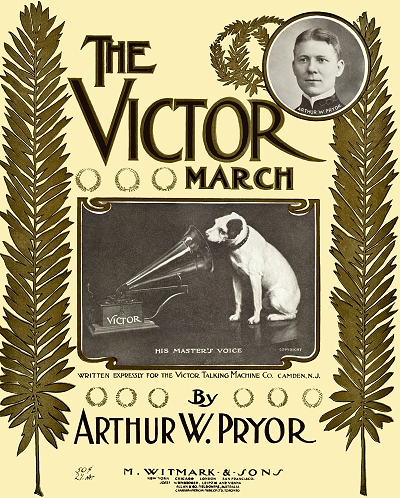 Sousa already had some bias against recordings and the whole process, ultimately having only conducted four or five recording sessions, three of them much later in his career. For their work on the Victor and Berliner labels, participating band members could pad their pockets with a bit of extra cash. Arthur may have conducted as much as 75% of the recordings made up until 1903, with Clarke and a couple of other principals taking most of the rest of the sessions.
Sousa already had some bias against recordings and the whole process, ultimately having only conducted four or five recording sessions, three of them much later in his career. For their work on the Victor and Berliner labels, participating band members could pad their pockets with a bit of extra cash. Arthur may have conducted as much as 75% of the recordings made up until 1903, with Clarke and a couple of other principals taking most of the rest of the sessions.
 Sousa already had some bias against recordings and the whole process, ultimately having only conducted four or five recording sessions, three of them much later in his career. For their work on the Victor and Berliner labels, participating band members could pad their pockets with a bit of extra cash. Arthur may have conducted as much as 75% of the recordings made up until 1903, with Clarke and a couple of other principals taking most of the rest of the sessions.
Sousa already had some bias against recordings and the whole process, ultimately having only conducted four or five recording sessions, three of them much later in his career. For their work on the Victor and Berliner labels, participating band members could pad their pockets with a bit of extra cash. Arthur may have conducted as much as 75% of the recordings made up until 1903, with Clarke and a couple of other principals taking most of the rest of the sessions.Pryor had occasional clashes with Sousa, but they remained very respectful of their mutual talents at all times. Sousa had left the Marine Corps band in part due to the lack of financial gain for his hard work with that organization, and continued his work on a commercial basis. However, during a 1903 visit to Russia, it is reported that Arthur felt he was not getting his full financial due for his work, a move that evidently hurt Sousa, who gave him the option of breaking his contract at the end of the tour. So it was that Pryor decided to part with Sousa in 1903 to pursue a more artistic direction and feature his instrument more in the mix. His direction was more progressive than Sousa's, working to incorporate early jazz forms (before they had a name) rather than just continue on with marches, sprightly dances, and cakewalks. They remained on good terms throughout the rest of Sousa's life, with Pryor even filling in as a guest conductor now and then, and rarely failed to regard each other's role in the success of the famed band of John Philip Sousa.
Now on his own, Arthur needed recruit the best possible instrumentalists without raiding the Sousa band. He did take along one of his friends, Simone Mantia, who excelled at the five-valve euphonium and the baritone horn. Mantia took essentially the same role that Pryor had enjoyed with Sousa, that of assistant conductor, and when necessary, substitute soloist. Pryor had been a Conn instrument spokesman since the late 1890s, so they were also helpful in his launch. He also employed his brother Sam on the bass drum and percussion, and the younger Pryor would remain in that position for most of his career. The Pryor Band, fully outfitted with Conn instruments as an early example of product placement, debuted at the Majestic Theater in New York on November 15, 1903. The unintentionally lengthy affair warranted several good reviews that appeared in papers far outside of New York City. The New York Morning Telegraph of November 16, 1903, waxed effusively about the band and their debut:
Arthur Pryor and his band achieved a genuine success at the Majestic Theatre last night. Every number was twice encored and several selections received a third encore. At the conclusion of the organization's first concert it was the unanimous verdict that rarely has so fine a band been heard in this city.
Mr. Pryor himself received an ovation upon his entrance. For five minutes he blushed and bowed. But he handled the first number on the programme, the eccentric overture to "Il Guarany," in a manner which proved him a master of the baton
His style is impressive, though perhaps not quite so picturesque as that of John Philip Sousa, although some of his former chief's tricks of conducting were noticeable at times. For an encore the band played one of Pryor's own marches, a stirring composition full of quaint and comical orchestral effects. It won instant approval from the audience.
Simone Mantia with a euphonium solo won almost as much applause, and for an encore played "Bedelia," which was laughingly welcomed.
The third number on the programme was a new dance suite of three numbers composed by Mr. Pryor. This one hearty applause, and for a third recall the band played Sousa's "Stars and Stripes Forever" in a most impressive maner. In this Mr. Pryor has introduced an innovation. For the finale, three piccolo players, six cornetists and six trombonists leave their seats and line up, facing the audience, so that the counter effects may be rendered with full force…
It was an evening of high-class orchestral enjoyment, classical music and "ragtime" being sandwiched in the programme, with the "ragtime" predominating, but every number was rendered in an almost perfect manner… There is no doubt of the success of Arthur Pryor and his band.
After the launch Pryor's band started a tour of the US, the first of six that went through 1909. Early the following year, having had no real roots other than his parents' theater in St. Joseph, Arthur established himself as a resident of the shore side town of Asbury Park, New Jersey,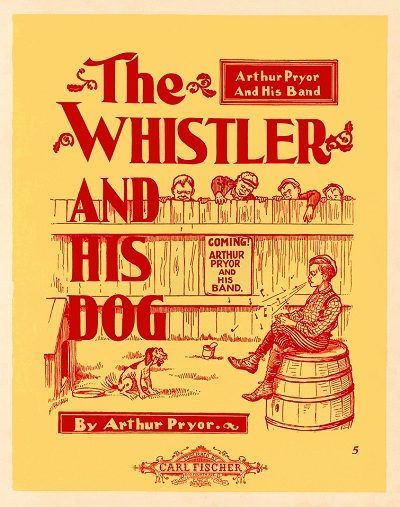 which also had a few venues in which his band could play for reasonable money during the lucrative summer seasons. One of those was a band pavilion on the boardwalk, which was eventually named for him. They would become a staple of that resort town through at least the early 1920s. They also played often in the late spring at Willow Grove Park just north of Philadelphia, usually just ahead of their summer engagements and after their tours. Many winters were spent down in the Miami, Florida, area at the Royal Palm Park.
which also had a few venues in which his band could play for reasonable money during the lucrative summer seasons. One of those was a band pavilion on the boardwalk, which was eventually named for him. They would become a staple of that resort town through at least the early 1920s. They also played often in the late spring at Willow Grove Park just north of Philadelphia, usually just ahead of their summer engagements and after their tours. Many winters were spent down in the Miami, Florida, area at the Royal Palm Park.
 which also had a few venues in which his band could play for reasonable money during the lucrative summer seasons. One of those was a band pavilion on the boardwalk, which was eventually named for him. They would become a staple of that resort town through at least the early 1920s. They also played often in the late spring at Willow Grove Park just north of Philadelphia, usually just ahead of their summer engagements and after their tours. Many winters were spent down in the Miami, Florida, area at the Royal Palm Park.
which also had a few venues in which his band could play for reasonable money during the lucrative summer seasons. One of those was a band pavilion on the boardwalk, which was eventually named for him. They would become a staple of that resort town through at least the early 1920s. They also played often in the late spring at Willow Grove Park just north of Philadelphia, usually just ahead of their summer engagements and after their tours. Many winters were spent down in the Miami, Florida, area at the Royal Palm Park.Many of the tour stops were longer engagements rather than just weekends, although in-between destinations they would give special concerts as well. The Pryor organization spent a good chunk of time at the 1904 Lewis and Clark Exposition in St. Louis. Back in New York in mid-1904, Pryor was engaged to conduct an enormous congregation of around 1,000 pieces from 56 different bands for the opening of the new Dreamland amusement park on Coney Island that summer. But most of his summers were spent near his new home in New Jersey. As a matter of course, as they were now a brand with a future, the Pryor Band was legally incorporated in Albany, New York in mid-1906.
As a composer, Pryor was fairly productive, turning out more dances and marches than rags or cakewalks, yet still curiously billed as "The King of Rags" in one Victor record catalog. Having done so much work at the early Sousa recording sessions, including setting up the instruments for the most effective recording into the horns, he was designated as the studio director of the recently formed Victor Talking Machine Company for several years as well, as Victor tried to edge out cylinder companies like Columbia and Edison with their own popular products. This eventually turned into over 2500 sides cut during the next two and a half decades, considerably more than most any other band of that era. Their first official Victor session was just nine days after the band's New York debut, and included some of the numbers played at that concert. In fact, much of December, 1903, was spent in the Victor studio knocking off varying renditions of their works on 7-, 10- and 12-inch discs.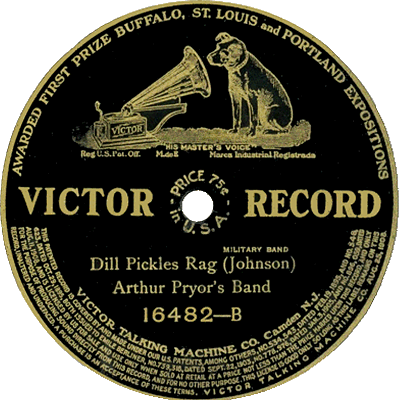 A similarly impressive stint took place in the latter half of April through mid-May, 1904. Pryor's Razzazza Mazzazza was a fairly popular number in concert and on record, as were a number of Pryor originals. But his most popular piece by far would soon turn out to be The Whistler and His Dog, in part because of the audience participation aspect since even though most could not play instruments with the band, they could certainly whistle.
A similarly impressive stint took place in the latter half of April through mid-May, 1904. Pryor's Razzazza Mazzazza was a fairly popular number in concert and on record, as were a number of Pryor originals. But his most popular piece by far would soon turn out to be The Whistler and His Dog, in part because of the audience participation aspect since even though most could not play instruments with the band, they could certainly whistle.
 A similarly impressive stint took place in the latter half of April through mid-May, 1904. Pryor's Razzazza Mazzazza was a fairly popular number in concert and on record, as were a number of Pryor originals. But his most popular piece by far would soon turn out to be The Whistler and His Dog, in part because of the audience participation aspect since even though most could not play instruments with the band, they could certainly whistle.
A similarly impressive stint took place in the latter half of April through mid-May, 1904. Pryor's Razzazza Mazzazza was a fairly popular number in concert and on record, as were a number of Pryor originals. But his most popular piece by far would soon turn out to be The Whistler and His Dog, in part because of the audience participation aspect since even though most could not play instruments with the band, they could certainly whistle.The role of Pryor with the Victor organization was important in the development and growth of the recording industry. While Sousa was less than enthusiastic about phonographs, Pryor appears to have understood the reach of the medium, including on cylinders which he rarely recorded on. Bands like Sousas could reach a few thousand people a week, but only for a fleeting moment before they moved one. While the importance of live concerts and the musical culture surrounding them should not be dismissed in any way, having a document of those performances that consumers could continually enjoy in perpetuity helped to spread the fame of the band even further, and achieved the mission of putting fine music into the hands of people who might otherwise not have heard Pryor's group, or any fine group, due to financial or geographic barriers. It also kept his musicians employed year-round. In his 25 years at Victor as a staff member, spanning early horn recordings to early electronically recorded discs, it is clear that Arthur Pryor was focused on this method of musical distribution at times more so than concertizing. As such, he left a legacy of performances that remain a aural window into the classical and popular music of that era, and even preserved in digital form they have a fresh quality about them that not all recording artists or companies captured in the 1900s and 1910s. Not only did he conduct his band for Victor, but an orchestra, and he also continued to conduct Sousa's band for their recordings.
After 1909 Arthur decided to stop touring and settle for good into his home at Asbury Park with his wife and his two sons. He and his family appeared there for the 1910 enumeration, where he was listed as a band leader. During this time his band focused on recording, and on more stable seasonal work at many local amusement venues, including the one at Asbury Park and also Willow Grove.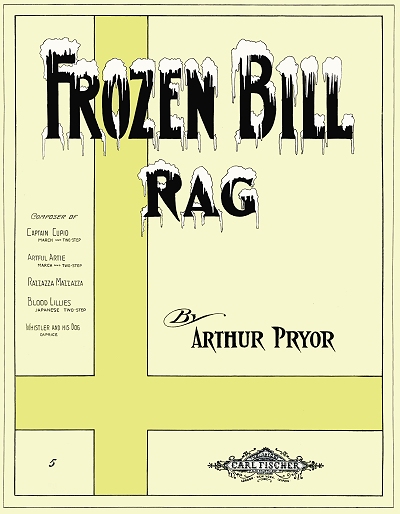 The output of Victor recordings in 1910 alone is extraordinary, and surpasses that of many other groups for the entire catalog on that label. He was clearly a perfectionist, and according to interviews with band members, had frequent outbursts of temper laced with swearing. One of these was overheard a a lady of note during their run at Willow Grove, and resulted in a multi-year ban on the Pryor organization, which eventually returned. On another occasion one band member who was ostracized during a performance was escorted from the stage by security, with most of the band following him in sympathy, all while a piece was in progress. Arthur paused for a moment, then turned to the audience and played Auld Lang Syne in his inimitable style, prompting a gradual return of the band who joined in. In spite of his temper he was well-liked by his men, and unlike most conductors, he would join them for meals and other social gatherings, engendering loyalty and friendship.
The output of Victor recordings in 1910 alone is extraordinary, and surpasses that of many other groups for the entire catalog on that label. He was clearly a perfectionist, and according to interviews with band members, had frequent outbursts of temper laced with swearing. One of these was overheard a a lady of note during their run at Willow Grove, and resulted in a multi-year ban on the Pryor organization, which eventually returned. On another occasion one band member who was ostracized during a performance was escorted from the stage by security, with most of the band following him in sympathy, all while a piece was in progress. Arthur paused for a moment, then turned to the audience and played Auld Lang Syne in his inimitable style, prompting a gradual return of the band who joined in. In spite of his temper he was well-liked by his men, and unlike most conductors, he would join them for meals and other social gatherings, engendering loyalty and friendship.
 The output of Victor recordings in 1910 alone is extraordinary, and surpasses that of many other groups for the entire catalog on that label. He was clearly a perfectionist, and according to interviews with band members, had frequent outbursts of temper laced with swearing. One of these was overheard a a lady of note during their run at Willow Grove, and resulted in a multi-year ban on the Pryor organization, which eventually returned. On another occasion one band member who was ostracized during a performance was escorted from the stage by security, with most of the band following him in sympathy, all while a piece was in progress. Arthur paused for a moment, then turned to the audience and played Auld Lang Syne in his inimitable style, prompting a gradual return of the band who joined in. In spite of his temper he was well-liked by his men, and unlike most conductors, he would join them for meals and other social gatherings, engendering loyalty and friendship.
The output of Victor recordings in 1910 alone is extraordinary, and surpasses that of many other groups for the entire catalog on that label. He was clearly a perfectionist, and according to interviews with band members, had frequent outbursts of temper laced with swearing. One of these was overheard a a lady of note during their run at Willow Grove, and resulted in a multi-year ban on the Pryor organization, which eventually returned. On another occasion one band member who was ostracized during a performance was escorted from the stage by security, with most of the band following him in sympathy, all while a piece was in progress. Arthur paused for a moment, then turned to the audience and played Auld Lang Syne in his inimitable style, prompting a gradual return of the band who joined in. In spite of his temper he was well-liked by his men, and unlike most conductors, he would join them for meals and other social gatherings, engendering loyalty and friendship.Arthur commenced composing primarily during the winter months. Some of these works found their way into publication as piano reductions or solos, particularly his intermezzos and rags. Among his more popular sheets were Captain Cupid, The Arcade Girl, and the fine rag Frozen Bill. Although he did not work directly with a single publisher, and given his schedule barely had the capacity to do so, many of his pieces were issued by either M. Witmark & Sons or Carl Fischer, both New York houses. Many noted musical celebrities appeared with him during the 1910s, including noted pianist Anton Rubinstein in late summer of 1916. Pryor was also engaged to write special works. The first of these in 1910 was music for an adaption of the German written play There and Back, titled Jinga-Boo, with lyrics by Alfred Bryant. Little was found on its actual production. The next was a new score for the half-century old stage play Uncle Tom's Cabin in 1912. This was followed by On the Eve of Her Wedding, about which even less is known.
Pryor became one of the charter members of ASCAP in 1914. In the late teens his regular gigs got extended to additional venues in Miami, Florida as well, and he was engaged for a few years with the Capitol Theater in New York City. There Pryor was the first to present a composition by another future star, Swanee by George Gershwin. He was also present with his band when Woodrow Wilson received his second Democratic nomination for the presidency in 1916.
However, by 1920 Pryor had to spend so much time planning concerts and recordings and conducting that he finally put his trombone down, at least in a professional capacity, as he still reportedly played it every day in private. Being a perfectionist, he had not soloed on a recording since 1912, and he preferred to have other top-notch trombonists playing his notated solos rather than appearing to be less than his very best.
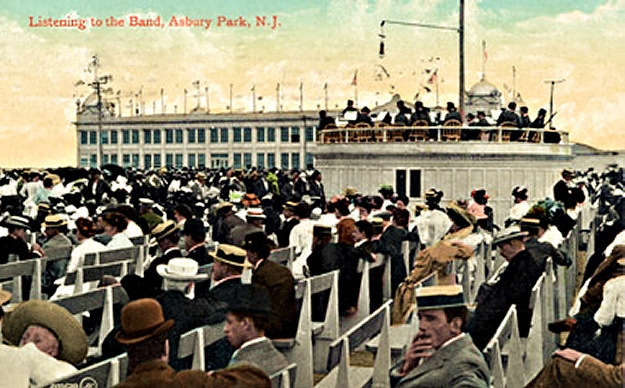 |
This does not mean that Pryor totally gave up his association with the instrument. In 1921 he was endorsing Holton brass instruments now, which were manufactured by former band member Frank Holton in Wisconsin. (The author owns a Holton trumpet purchased by his grandfather in 1926, and can assure the reader it was among the very finest of instruments of that time.) Arthur spent the next decade making recordings and playing for radio until he retired from regular work. He was noted as playing the winter season in Miami in the 1920s, giving daily concerts with a variety of guest artists. Pryor maintained a second home there, and in 1924 obtained a celebrated Steinway B for that home. In both Florida and New York, a core of his group, estimated at 25 musicians, also made appearances on broadcast radio from 1921 into the following decade, much of it in association with the National Broadcasting Network (NBC). Even though much of the time was spent in Asbury Park, or more properly, Deal, New Jersey,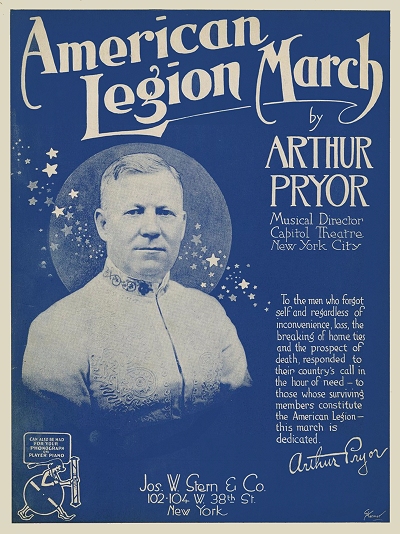 during his 25 continuous seasons there, Arthur and Maude were shown as residing in Manhattan for the 1930 enumeration, where he was listed as a musician and broadcaster.
during his 25 continuous seasons there, Arthur and Maude were shown as residing in Manhattan for the 1930 enumeration, where he was listed as a musician and broadcaster.
 during his 25 continuous seasons there, Arthur and Maude were shown as residing in Manhattan for the 1930 enumeration, where he was listed as a musician and broadcaster.
during his 25 continuous seasons there, Arthur and Maude were shown as residing in Manhattan for the 1930 enumeration, where he was listed as a musician and broadcaster.Pryor ostensibly retired from the demands of steady musical work in 1933 at the age of 63. The couple then moved permanently to Driftwood, a 27-acre farm they had acquired some years prior, near Long Branch, New Jersey. Joining them were Mr. and Mrs. C.D. Haviland, their in-laws through the marriage of Arthur, Jr. to his wife. As Maude was a skilled pianist, they would occasionally have musical evenings at home with their friends. Arthur maintained a studio in the Time (later Time/Life) building in New York, as well as one at the newly completed Rockefeller Center, as per his broadcasting association with NBC and his ongoing relationship with Conn. His students remember him largely as looking for perfection, and encouraging slow progress over sloppy progress. He never wrote a method book, but instead taught them from other texts and select repertoire. Pryor was also involved with working to develop better band programs in the public schools, especially in regards to the repertoire of the classics and good marches. As progressive as his point of view had been three decades earlier, he now considered jazz to be a "musical parasite" that was lowering the tastes of the American public.
In the interim, Arthur, Jr., who had played cornet and piano during the latter years of his father's band, in addition to doing some conducting in his place, had become a notable musician in his own right. The Pryor's son Roger, on the other hand, had gone into the acting profession, making a mark in Hollywood. He was also a trombonist, pianist, saxophonist and bandleader, but spent more his time in front of the camera or the radio microphone. In his capacity as bandleader on the radio, he had adopted his own arrangement of The Whistler and His Dog as his opening theme. As for Arthur in retirement, in addition to his trips to New York City he became briefly involved in politics, holding elected office for a three-year term during the height of the Great Depression on the Board of Freeholders for Monmouth County, New Jersey.
Performing only occasionally over the next few years, Arthur was asked to come to the podium again shortly after the start of World War II, returning to Asbury Park for a summer series that would also be broadcast on the radio. As most such events had been restricted due to wartime policies, this was considered a very special event. They launched the series on Memorial Day weekend, 1942. Three weeks later on June 17, during was after a rehearsal for the radio program, Arthur collapsed from a stroke and never regained consciousness. He died the following morning at home at age 72. Arthur Jr. stepped into his father's shoes for a time, including the day of his father's death and the essential July 4 concert two weeks later. He did this as a matter of course, and in order to keep his father's memory alive, continuing to do so for a few more years following. Arthur W. Pryor is interred in Glenwood Cemetery near his ranch in Long Branch. Maude subsequently moved to California to live with Roger, and passed on there on December 27, 1947, also at age 72.
While most of Pryor's works were for early dance bands or marches, he still left a significant legacy of compositions and recordings in the ragtime idiom that demonstrate his command of the genre, as well as his role in popularizing syncopated music forms among more conservative white audiences, while mixing it in with classic repertoire. His sheer volume of over 2000 recorded works gives us one of the better glimpses into the popular music of the late 1890s through 1910, when other artists like Al Jolson and Sophie Tucker started making popular recordings. Even his piano compositions incorporate many characteristics of his trombone playing into some very clever pianistic elements.
Some of the best examples of Pryor's work in modern recordings can be found through the considerable efforts of Rick Benjamin and his Paragon Ragtime Orchestra. I encourage you to seek out his recordings and further information bands of the era at www.paragonragtime.com Much of the information for this essay was derived from the usual government sources, as well as multiple newspaper articles and obituaries, plus a relatively good thesis and analysis of his life by Daniel E. Frizane first published as a paper in 1979 at the University of Kansas.